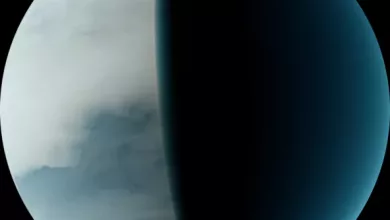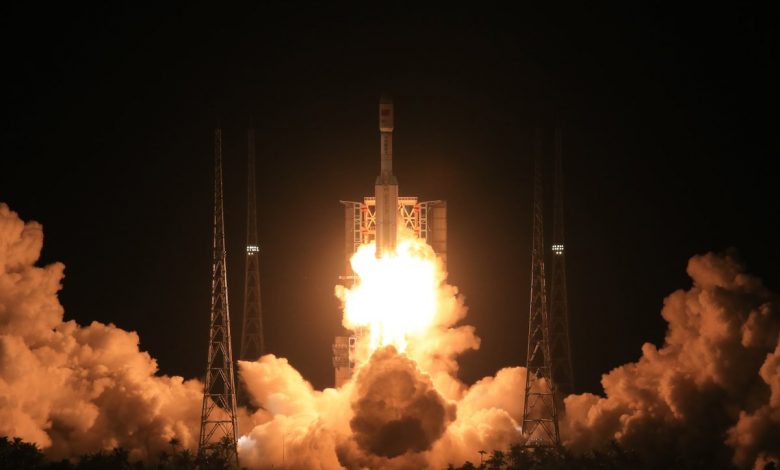
China has delivered a spectacular four-peat in space within a month following the successful launch of the Tianhe core cabin, Tianwen-1’s soft-landing on Mars, and Zhurong rover kicking off its grand journey on the Red Planet after driving off the landing platform, as a Long March-7 Y3 carrier rocket took off from Wenchang spaceport on the tropical island of Hainan in South China late Saturday night, sending the Tianzhou unmanned cargo spacecraft into preset orbit for an epic space station supply mission.
China has launched its Tianzhou 2 cargo mission to its new space station. Liftoff from the Wenchang Spacecraft Launch Site occurred Saturday, 29 May at 12:55 UTC / 08:55 EDT aboard a Chang Zheng 7 rocket following two previous scrubbed launch attempts in early May.
Tianzhou 2 marks the second flight of the uncrewed Tianzhou spacecraft, which China uses to resupply its newly-launched space station, and the first such mission in support of a crew. After launch, the spacecraft successfully docked to the Tianhe module at 21:01 UTC / 17:01 EDT.
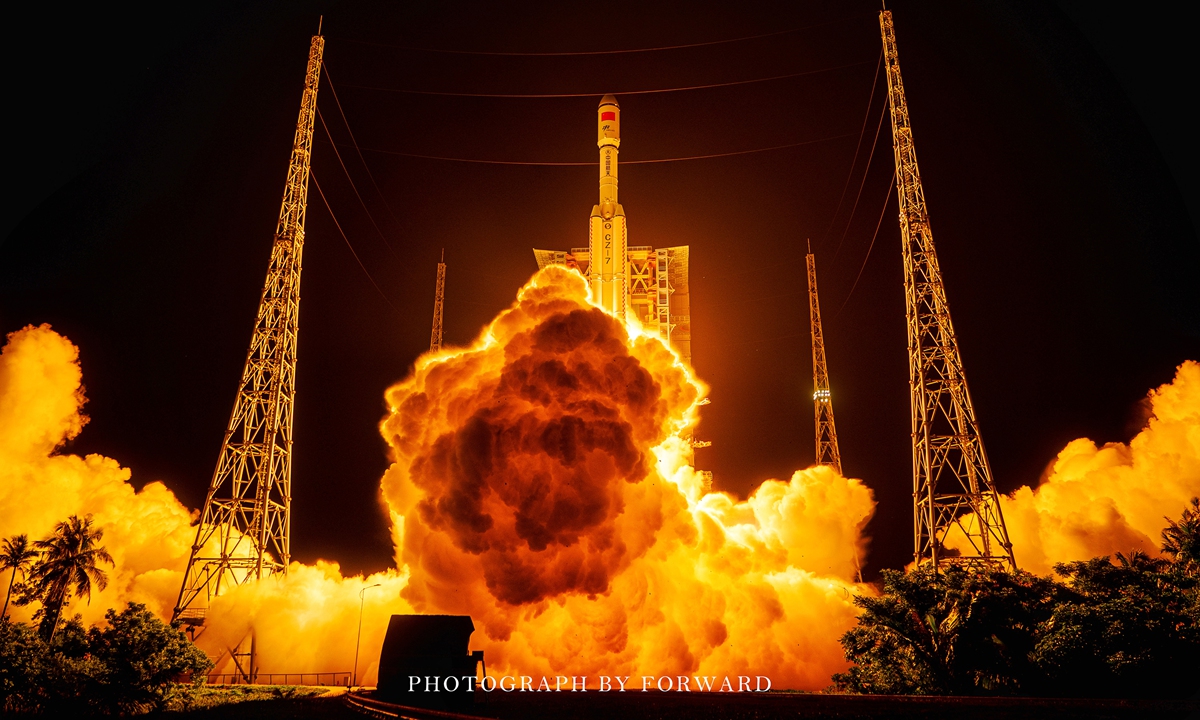
Tianzhou history and mission
Tianzhou 1 launched to the Tiangong 2 station in April 2017 and conducted a series of docking demonstrations and propellant transfer tests over the course of a five-month mission. This test flight was conducted after the departure of Tiangong 2’s only visiting crew – and ended with the Tianzhou spacecraft undocking and deorbiting to a destructive reentry.
The Tianzhou spacecraft is similar in function to the Progress spacecraft used by Russia (and formerly the Soviet Union) to resupply the last two Salyut stations, Mir, and the International Space Station. Cargo spacecraft play a vital role for long-duration space station expeditions by allowing provisions, replacement parts, and new scientific equipment and/or experiments to be delivered to the crew periodically. Other spacecraft fulfilling this role for the International Space Station include the US Cygnus and Cargo Dragon and the Japanese Kounotori (HTV) crafts — and formerly the European Automated Transfer Vehicle (ATV).
Like all of these spacecraft except for the Cargo Dragon, Tianzhou is designed for a one-way trip to the Chinese space station. At the end of its mission, it will be deorbited and burn up as it reenters the Earth’s atmosphere.
Tianzhou 2’s launch is the first mission to dock with China’s new space station, following the successful launch of the Tianhe core module last month. The arrival of Tianzhou 2 and the supplies it is bearing is the last major milestone before the first crewed launch to the station, currently slated for no earlier than 10 June with the Shenzhou 12 mission.
Tianzhou 2 docked at the aft port of the Tianhe module and will remain there through most of the three-month Shenzhou 12 expedition. It is carrying 4,690 kilograms of supplies and equipment for the station and its first crew, including a pair of spacesuits, crew provisions, and equipment for installation activities inside and outside of the outpost. The spacecraft is also carrying 1,950 kilograms of propellant, which can be used for maneuvering or transferred to the Tianhe core module.
Towards the end of the Shenzhou 12 crew’s stay aboard the space station, Tianzhou 2 is expected to undock to perform a rendezvous test. After Shenzhou 12 departs the station, Tianzhou 2 will re-dock at the forward port that Shenzhou previously occupied. Once re-docked, a propellant transfer test will be conducted.
Shortly after Shenzhou 13 arrives at the station in October, the crew will test the station’s robotic arm by relocating Tianzhou 2. After the robotic arm test, Tianzhou 2 will depart the space station loaded with trash and unneeded hardware for disposal.
The Tianzhou 2 mission will occur during the “Critical Technology Validation Phase” of the new space station program. This is the first of three phases of operation, lasting from the launch of Tianhe up to the departure of the second crew aboard Shenzhou 13 early next year. This will encompass checkout and preparation of the Tianhe module before the second, or “Construction Phase”, commences — during which the Wentian and Mengtain science modules will arrive. Once these have been installed, tested, and configured, the station will enter its final “Operational Phase” in 2023.
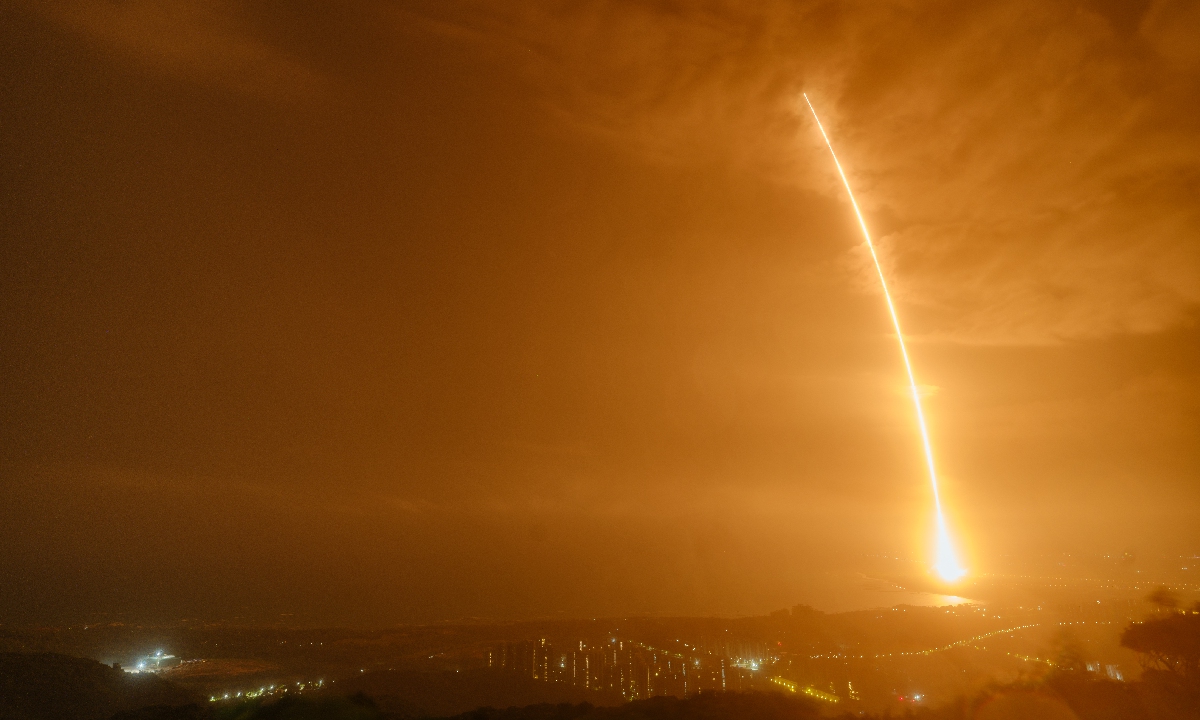
Launch
The Tianzhou-2 cargo spacecraft was originally slated to be launched at around 1:30 am on May 20 and to head to China’s Tianhe space station core cabin, which was launched into orbit on April 29, for a supply run. However, the launch was scrubbed narrowly following an announcement from CMSA on the early morning of May 20 for “technical reasons.”
Following the announcement of the successful launch, the People’s Daily disclosed Saturday that on May 20, within less than four hours of the planned launch, which was planned at around 1:30 am, the ground command center found a parameter indicating pressure levels returning abnormal data, indicating that the rocket could no longer meet the launch requirements.
Tianzhou 2 was launched aboard a Chang Zheng 7 (CZ-7) – also known as Long March 7 – a two-stage vehicle which forms part of China’s new-generation fleet of modular rockets.
The vehicle’s first stage consists of a 3.35 meter core powered by a pair of YF-100 engines. This is surrounded by four side-mounted boosters, each with a single additional YF-100. The second stage retains the same diameter as the first stage and is powered by a single YF-115 engine.
Tianzhou 2’s launch marked the fifth flight for the Chang Zheng 7 rocket overall and the third to use the CZ-7 configuration. The other two launches used the CZ-7A variant, which adds a cryogenic-propellant third stage to enable geostationary launches.
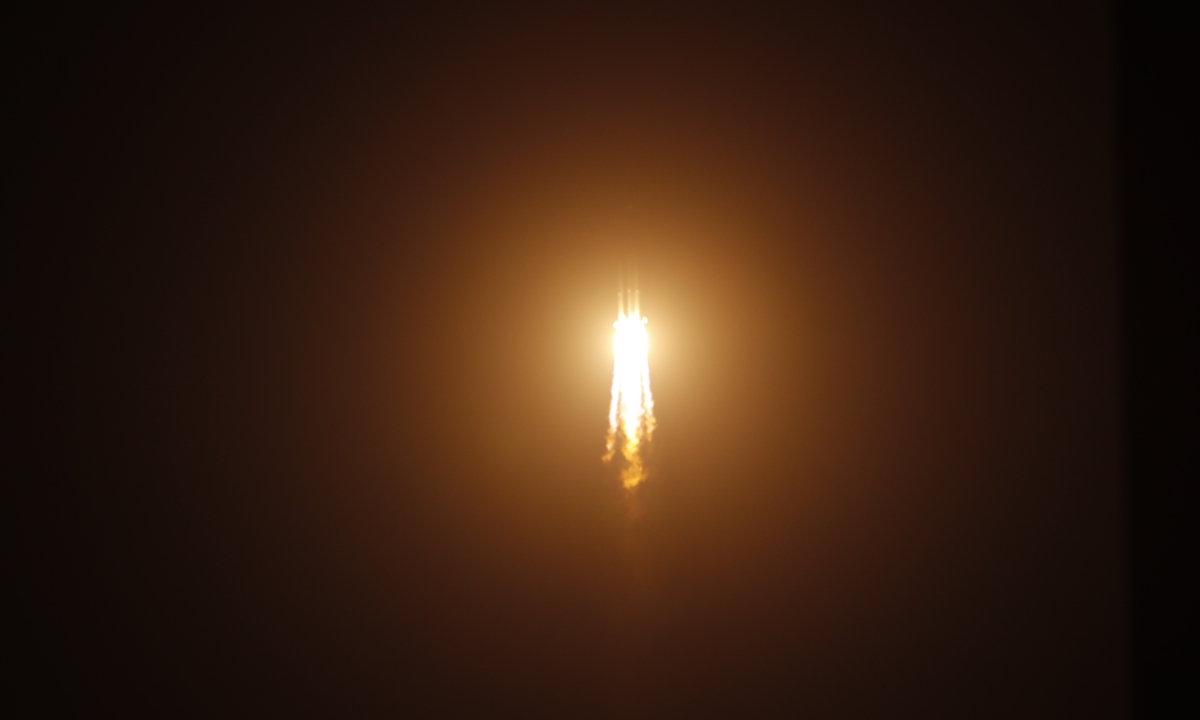
The first flight of the Chang Zheng 7 came in June 2016, carrying a scaled-down prototype crew capsule to support testing for future human spaceflight projects. The rocket’s second flight, ten months later, carried Tianzhou 1 into orbit. Two CZ-7A launches took place in March 2020 and March 2021 with experimental geosynchronous satellites aboard, with the 2020 launch failing to reach orbit due to an issue around the time of first stage separation. This remains the only failure for the CZ-7 series, with an investigation determining the most likely cause to be a premature cutoff of one of the four boosters, although other reports suggested the vehicle disintegrated shortly after second stage ignition.
The Chang Zheng 7 for Tianzhou 2 is numbered Y3, reflecting its status as the third flight of the two-stage CZ-7. CZ-7A rockets are numbered separately.
The CZ-7 is part of a wider family of rockets that China has introduced over the last few years, which will eventually replace their ageing fleet of Chang Zheng 2, 3 and 4 rockets that currently account for most of the country’s launches. The newer family of rockets are designed around a series of modular core stages: for example, the 3.35 meter core that is used as the first stage of the CZ-7 also serves as the first stage of the Chang Zheng 8 and as the side-mounted boosters for the Chang Zheng 5. A shortened single-engine version is used as the first stage of the Chang Zheng 6.
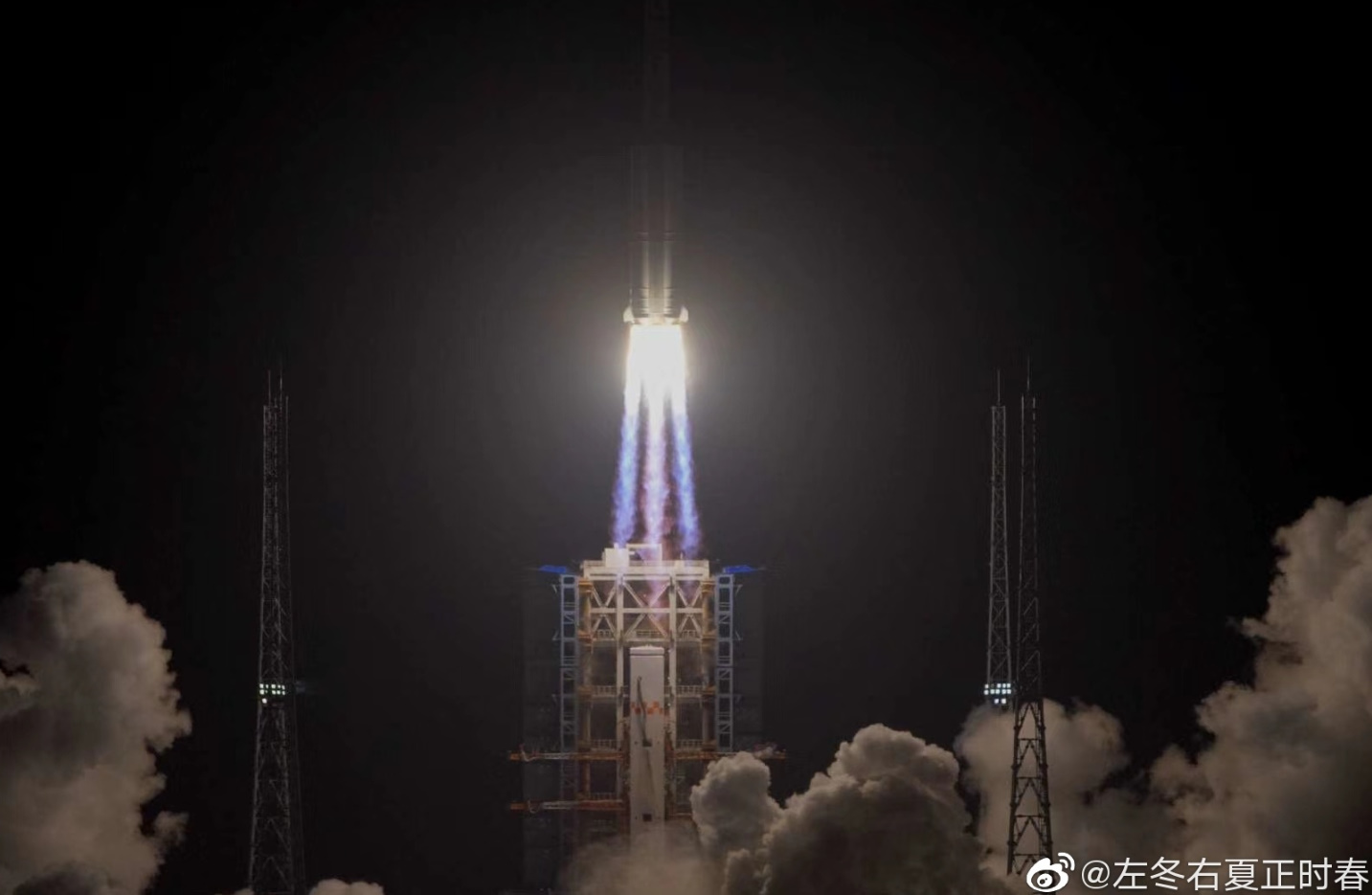
Unlike the earlier Chang Zheng rockets, which used storable and highly toxic hypergolic propellants, CZ-7’s engines burn rocket-grade kerosene, oxidised by liquid oxygen. This is a cleaner, less toxic and more efficient combination which reflects the fact the rockets are purpose-built for satellite launches, whereas the previous-generation rockets were derived from ballistic missiles where the main consideration was keeping them ready to launch at a moment’s notice for extended periods of time.
Tianzhou 2’s launch took place from the Wenchang Spacecraft Launch Site on Hainan Island off China’s southern coast. Originally a sounding rocket launch facility, Wenchang was rebuilt as China’s fourth orbital launch site to support the country’s next-generation rockets. From its coastal location, rockets can fly out over the South China Sea, reaching a wide range of orbits without dropping spent stages over land.
Per local reports the launch of Tianzhou 2 to the CSS has been rescheduled to today at around 17:09 UTC.https://t.co/SYKm7jc9Kx
— Cosmic Penguin (@Cosmic_Penguin) May 20, 2021
China nevertheless attracted criticism last month after the core stage of the Chang Zheng 5B rocket, launched from Wenchang to deploy Tianhe, was left in orbit to make an uncontrolled re-entry. While spent rocket stages being discarded in orbit is not unusual, the Chang Zheng 5B’s core stage was significantly larger, leading to concerns that debris might survive and reach the ground. In the end, the CZ-5B core re-entered on 9 May — with any debris that survived falling into the Indian Ocean.
With the smaller CZ-7 rocket being used for Tianzhou 2’s launch, only the smaller second stage and payload will reach orbit.
The rocket was rolled out to Wenchang’s Pad 201 on Sunday, 16 May in preparation for launch. Pad 201 is one of two launch pads at Wenchang and is shared by the Chang Zheng 7 and Chang Zheng 8 rockets. The larger Chang Zheng 5 vehicles fly from Pad 101, situated 650 meters to the southwest.
Both launch pads use vertical integration away from the pad itself. Two vertical assembly buildings are located approximately 2.4 kilometers to the north. The CZ-7 was assembled atop a mobile launch platform, which was then moved into position at the launch pad along rails. An umbilical tower mounted on the launch platform hosts the cables and lines that will be used to power, fuel, and prepare the rocket for launch, while a larger service tower at the launch pad contains work platforms to provide access for final inspection and pre-launch preparations.
China’s next launch will occur in about a week’s time, with a Chang Zheng 3B due to lift off from Xichang with the Fengyun-4B weather satellite. The next Chang Zheng 7 launch is expected in September with Tianzhou 3.
In order to precisely send the payload of the Tianzhou cargo spacecraft to the same space orbit as the Tianhe core cabin for a smooth rendezvous, developers of the Long March-7 Y3 said they have adopted a new automatic course correction technology, enabling the rocket to overcome minor orbital deviance, if any occurs at launch or during flight, and expand the launch window from zero to some two minutes.
They also said that the design reliability of the rocket type has reached 0.98, a world leading standard. Its transfer process is able to weather a strong Force 8 gale, and it can also be launched in rain.
Apart from four cargo spacecraft launch missions in the following two years in the space station construction phase, Long March-7 will keep a mission frequency of two launches every year in the operation phase of the space station, developers revealed.
Next, the Shenzhou-12 crewed spacecraft is scheduled for launch via the Long March-2F carrier rocket in June, sending three astronauts into orbit for about three months, during which the regenerative life support system and maintenance will be tested.
An intense schedule of 11 launches has been set for the construction of China’s space station, which started on April 29 with the launch of Tianhe core cabin and will continue through 2022. China’s space station is expected to become operational by around 2022.

